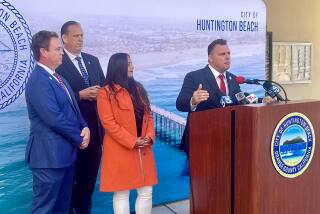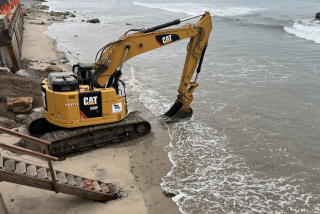Coastal Commission OKs Bolsa Chica Condo Project : Development: Planner gets go-ahead after agreeing to eliminate locked gates and give public access to coast and parkland. Critics will keep pushing for fewer units.
HUNTINGTON BEACH — The California Coastal Commission on Thursday approved a controversial condominium project on the mesa above the Bolsa Chica wetlands, but only after the developer agreed to eliminate locked gates and provide public access to the coast and adjacent parkland.
The 252-unit Surfcrest North project, to be built on 10 acres in Huntington Beach’s most prized natural area, has been fought by local environmentalists and some city leaders for several years. They called Thursday’s decision a partial victory, and said they will continue to push for changes in the project, especially fewer units.
“To plunk down the densest project in our whole city right next to our linear park and wetlands is wrong,” said Coastal Commission member Linda Moulton-Patterson, who also serves on the Huntington Beach City Council. “But we did make some progress here today.”
The approval by the Coastal Commission overcame a major hurdle for developers of the ocean-view project, which will consist of six three-story buildings at the northwest corner of Palm Avenue and Seapoint Street, next to the proposed Bolsa Chica Regional Park.
The Huntington Beach City Council approved the private, gated community last summer, and Mayor Grace H. Winchell and the environmental group Amigos de Bolsa Chica then appealed it to the state Coastal Commission.
The commissioners decided Thursday that the condominiums complied with all Coastal Act requirements except for public access, since it cut off a route to the area’s popular bluff top and view areas.
They required the developer, Surfcrest Partners, to eliminate gates, allow public use and parking on the condominium project’s streets and provide a sidewalk to adjacent parkland.
Surfcrest Partners vice president Tom Zanic immediately agreed to the changes, which he said “can be accommodated to the satisfaction of the commission.”
Winchell said she is pleased by the public access but disappointed that the Coastal Commission did not order changes in Surfcrest North’s density or affordable housing requirements.
“Out of the three concerns we had, we won one and a quarter,” the mayor said. “It was really good that they focused on access . . . but this project has too high of a level of human habitation in my opinion.”
At an April meeting, the coastal commissioners had said Surfcrest North did not provide enough affordably priced units. In a surprise move, Surfcrest Partners then agreed to reserve 156 of the 252 units as affordable housing and the commission delayed its vote until Thursday.
Zanic said the 800- to 1,600-square-foot homes are estimated to cost between $150,000 and $220,000.
Several commissioners complained Thursday that they don’t consider those prices low enough to qualify as “affordable,” especially in today’s lower-priced real estate market. But they concluded that the project complies with the city’s affordable-housing requirements.
“The issue is really (coastal) access,” said Coastal Commission Vice Chairwoman Lily Cervantes. “That is the only thing we can support our decision on.”
Adrianne Morrison, executive director of Amigos de Bolsa Chica, said she remains hopeful that changes in the project can still be negotiated. With the new conditions required by the state commissioners, the City Council may have to vote on it again, she said.
The City Council approved Surfcrest North last summer in a 5-2 vote, but the November election gave the council a new slow-growth majority.
Moulton-Patterson, who contends the density will harm resources at Bolsa Chica, was the only coastal commissioner to vote against the project Thursday.
The development’s 26 units per acre is nearly double the density of adjacent projects. Set by the city during the early 1980s, the density is so high because it is supposed to provide enough affordable housing to compensate for two other housing projects by the same developer.
Zanic stressed that the developer has worked with city and state officials for three years to comply with coastal and affordable housing requirements. He told the commissioners that public access is already provided “all around the property.”
More to Read
Sign up for Essential California
The most important California stories and recommendations in your inbox every morning.
You may occasionally receive promotional content from the Los Angeles Times.










